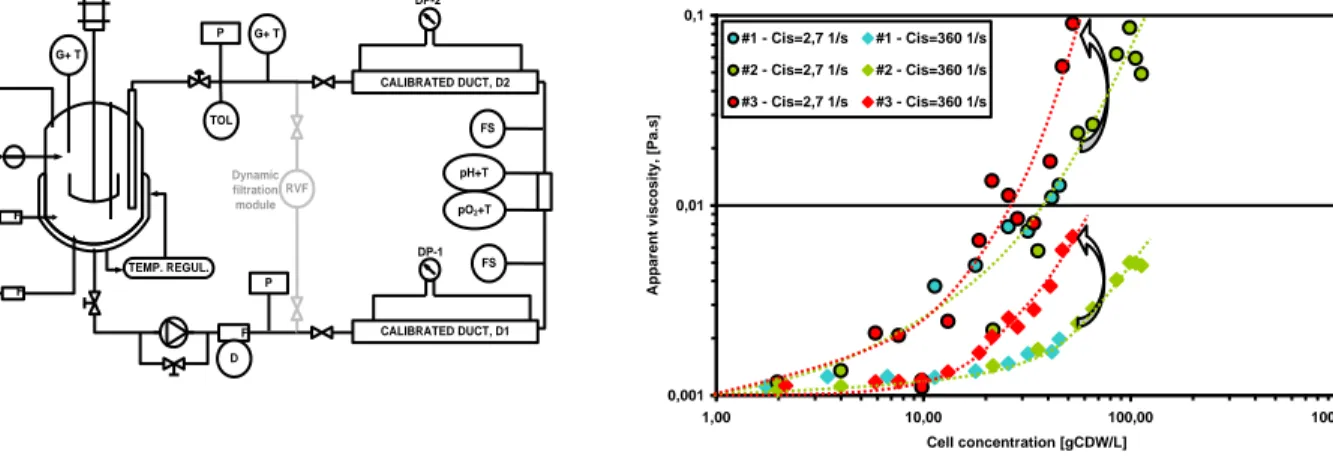To cite this version :
Kraiem, Hazar and Manon, Yannick and Anne-Archard, Dominique
and Fillaudeau, Luc
In-situ and ex-situ rheometry of high density
Yarrowia lipolytica broth: determination of critical concentration
and impact of yeastmycelial transition
. (2013) In: 48ème congrès
annuel du Groupe Français de Rhéologie - GFR 2013, 28 October
2013 - 30 October 2013 (Nantes, France). (Unpublished)
O
pen
A
rchive
T
OULOUSE
A
rchive
O
uverte (
OATAO
)
OATAO is an open access repository that collects the work of Toulouse researchers and
makes it freely available over the web where possible.
This is an author-deposited version published in :
http://oatao.univ-toulouse.fr/
Eprints ID : 10303
Any correspondance concerning this service should be sent to the repository
administrator:
staff-oatao@listes-diff.inp-toulouse.fr
In-situ and ex-situ rheometry of high density Yarrowia lipolytica
broth: determination of critical concentration and impact of
yeast-mycelial transition
Hazar KRAIEM1, Yannick MANON1,2, Dominique ANNE-ARCHARD2 and L. FILLAUDE AU1
1Laboratoire d’Ingénierie des Systèmes Biologiques et des Procédés (Université de Toulouse ; INSA ; INRA
UMR792, CNRS UMR5504), Toulouse, France
2Université de Toulouse ; INPT, UPS ; IMFT (Institut de Mécanique des Fluides de Toulouse), Toulouse,
France
Email :Luc.Fillaudeau@insa-toulouse.fr
Keywords : cell culture, fed-batch, in-situ and ex-situ measurements, physical and physicochemical properties, Yarrowia lipolytica
Abstract : The specificity of microbial bioreactions which give rise to irreducible couplings with hydrodynamics and heat and
mass transfers, led into complex (three phases medium) and dynamic (auto-biocatalytic reaction) systems. Cells (concentration, shape, dimension, physiology…) strongly affect physico-chemical properties of broth and the modification of these characteristics interacts with bioprocess performances (specific rates, yields…) with an improvement or, more generally, a decrease of yields.
CALIBRATED DUCT, D1 CALIBRATED DUCT, D2 RVF pH+T pO2+T DP-1 DP-2 G+ T P P G+ T Dynamic filtration module F AERATION F SUBSTRAT SALTS ANTIFOAM
ACID/BASE TEMP. REGUL. PRESSURE, TEMPERATURE, O2, pH SAMPLE ANALYSES IN L E T S OU TL E T S S T A TE F FS FS TOL D 0,001 0,01 0,1 1,00 10,00 100,00 1000,00 Cell concentration [gCDW/L] A p p ar en t vi sco si ty, [Pa. s] #1 - Cis=2,7 1/s #1 - Cis=360 1/s #2 - Cis=2,7 1/s #2 - Cis=360 1/s #3 - Cis=2,7 1/s #3 - Cis=360 1/s
Fig. 1: Overview of experimental set-up Fig. 2: Evolution of apparent viscosity (cell broth) as a function of cell concentration and impact of mycelial transition on rheological behaviour.
Our approach rests on physical and physico-chemical on-line and off-line measurements in respect with accurate and stringent conditions imposed by cell culture strategy. An original pilot based on a bioreactor (20L) with a derivation loop including a specific on-line rheometric device as well as additional physical and biological measurements is used. Axenic cultures of eucaryote microorganisms (Y. lipolytica) under pure oxidative fed-batch conditions are considered in order to evaluate biomass effect (concentration, morphology). Growth rate is controlled by carbon feed under synthetic mineral medium. Bioperformances related to oxygen transfer and physical properties of broth (in-situ and ex-situ rheometry) versus cell concentrations (0.1 to 110 gCDW/L), growth rate (cultures #1 and #2, µ=0.1 to 0.2h-1) and dimorphism generation (cultures #3, pH=5.5 to 7, µ=0.1h-1 for X>5gCDW/L) are considered. Cell morphology is scrutinized along fed-batch cultures. In-situ and ex-situ rheometry are consistent and complementary analysis indicating a shear-thinning behaviour. Critical cell concentrations are observed and a significant deviation of rheological behaviour is attributed to yeast-mycelial transition. A structured rheological model is established considering cell concentration (volume fraction), population balance and shear rate.
